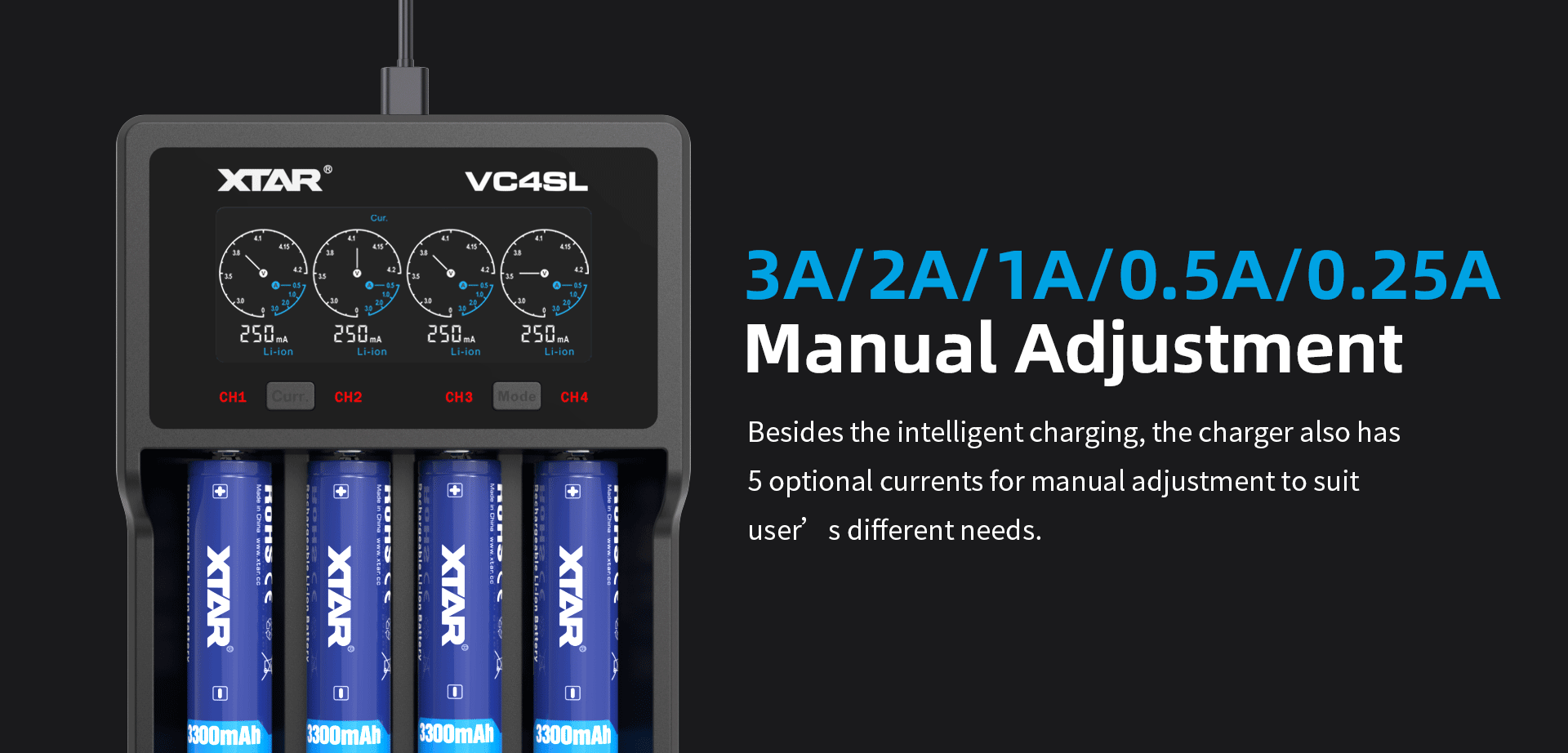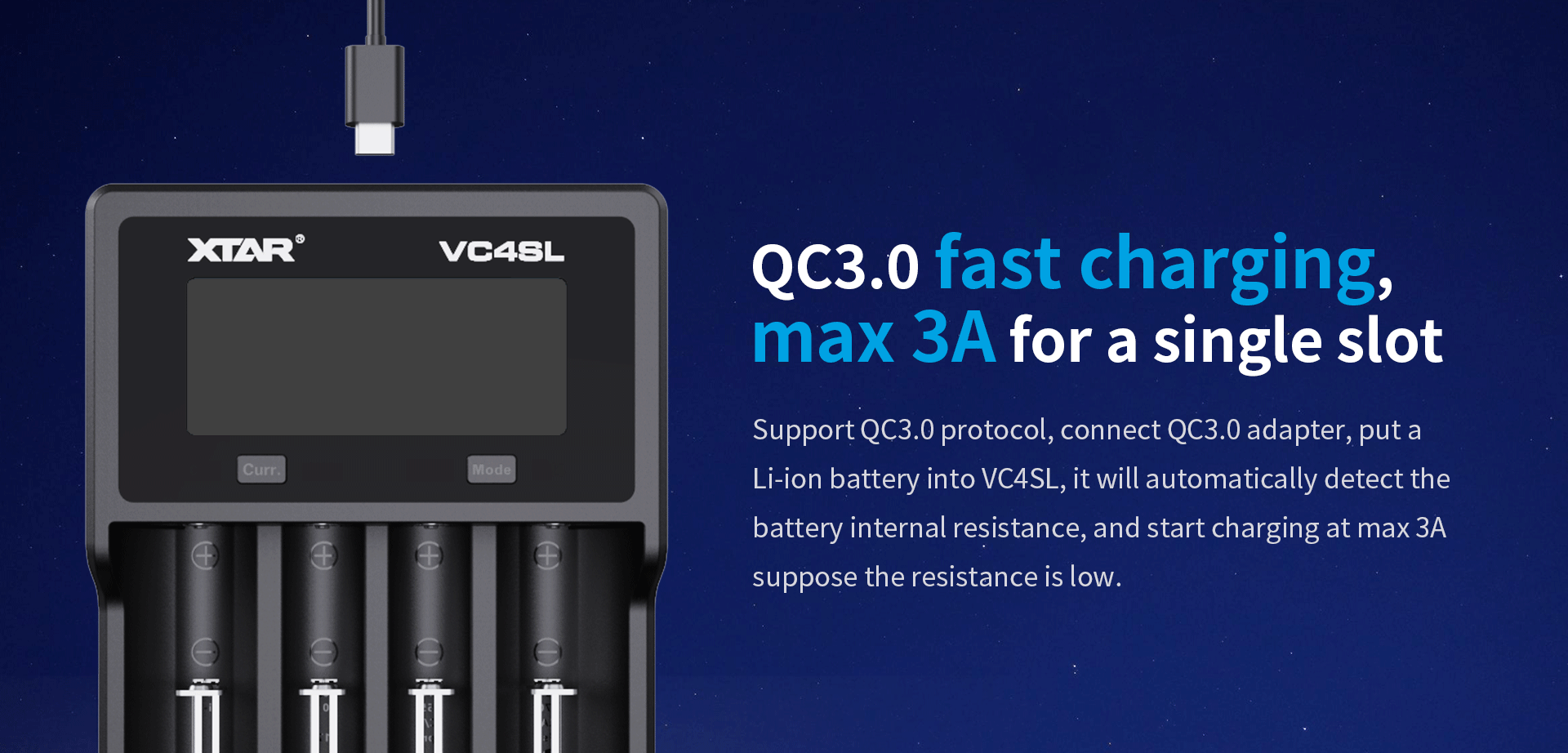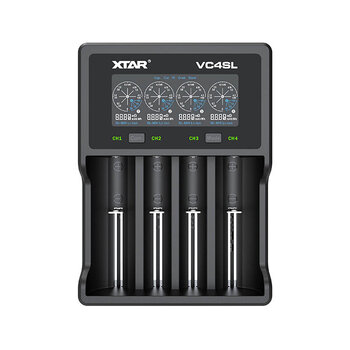Professional quad-channel processor charger
Xtar VC4SL - improved version of VC4S
for Li-ion and Ni-MH batteries in sizes 18650, AA, AAA and others
Key features
- support for protected 20700 and 21700 batteries
- charging Li-ion batteries controlled by a three-stage processor TC/CC/CV charging process
- CHARGING NI-MH batteries using the CC method
- four independent charging channels
- charging mode / grade mode (loading/discharging/charging) / storage mode
- 5 charging currents, manually selectable - 0.25A / 0.5A / 1A / 2A / 3A
- VA LCD display informing the charging capacity, cell voltage, charging current and internal resistance of the cell
- powered by any QC3.0 compliant charger
- reactivation function of deeply discharged cells
- protection: short-circuit, thermal, against reverse polarity
VC4SL is a professional processor charger with a three-stage TC/CC/CV charging process and AN LCD display. It charges 1-4 Li-ion cells 3.6 / 3.7V and Ni-MH of any capacity in sizes AAA/R03, AA/R6, R14/C, D, 10440, 14500, 14650, 16340, 17500, 17670, 18350, 18500, 18650, 18700, 20700, 21700, 22650, 25500, 26650, 32650. Including protected batteries 20700 and 21700
The backlit VA LCD display of the Xtar VC4SL charger shows real-time information about the battery's operating status: battery charge expressed in mAh, battery voltage, charging current and internal resistance of the cell. In addition, the VC4SL charger, in addition to the charging function, also has 2 other modes:
The "grade" mode allows you to show the exact capacity of the batteries. The charger in this mode charges the cells to full, then discharges them and then recharges them to full. The charger after the process shows the true capacity of the batteries (capacity from discharge). Another feature is the "storage" mode, where the charger does not charge the batteries to the end, but to the optimal voltage threshold in order to extend the life of the aging cell.
What is the TC/CC/CV charging method? It is a three-stage charging process for Li-ion cells to ensure that the cell is kept in good condition by charging with the right current at each stage and completing the charging process at the right time.
The individual stages of the TC/CC/CV process are:
- TC phase: cells discharged below 2.9V are 'woken up' with a lower current.
- CC phase: when 2.9V is reached, the cell is charged with a constant current of 0.25A to 3A
- CV phase: when the cell is almost charged, the charger switches to charging with a decreasing current until a voltage of 4.2V is reached on the cell. When 4.2V is reached, the charging process is completed - the battery is fully charged.
Charged batteries left in the charger will undergo a natural self-discharge process. Charging will resume when the voltage on the battery drops below 3.9V.
The Xtar VC4SL charger has the function of reactivating deeply discharged cells and cells with a voltage of 0V. Many chargers on the market are not able to charge such batteries. This is where the Xtar VC4SLcharger comes in handy, which in many cases allows you to 'rescue' such cells. Just insert the deeply discharged battery into the VC4SL charger, as with normal charging - the charger will detect the discharged cell and attempt to reactivate it.
Remark! Cells discharged below a certain level are irreversibly damaged and may not be possible to reactivate. Too deep discharge of Li-ion batteries should be avoided - this can lead to a significant reduction in their durability and capacity or lead to their complete failure.
In the set with the Xtar VC4SL charger we get a USB type C cable and a cover that facilitates the transport of the charger. A power supply is not included. Any charger with a USB socket is enough to power the charger (recommended charger compliant with the QC3.0 standard).









Produkt posiada oznaczenie CE.
- Akumulatory Li-ion 3,6-3,7V, niezabezpieczone
- Akumulatory Li-ion 3,6-3,7V, zabezpieczone (z PCM/PCB)
- Akumulatory Ni-MH
- QC 3.0 (5V/2A | 9V/2A) - gniazdo USB typ C
- Sterowana procesorowo TC/CC/CV dla Li-ion
- Sterowana procesorowo CC z -ΔV/0ΔV/PVD dla Ni-MH
- 0,25A / 0,5A / 1A / 2A / 3A
- 4,2V ±0,05V
- Reaktywacja głęboko rozładowanych ogniw i ogniw 0V
- Przed przegrzaniem ładowarki
- Przed przeciążeniem / zwarciem
- Przed odwrotną polaryzacją ogniw
- Ładowanie (Charge)
- Pomiar pojemności w mAh (Test)
- Pomiar rezystancji wewnętrznej w mOhm (Quick test)
- Storage - ładowanie w celu przechowania akumulatora
- Status pracy / ładowania
- Prąd ładowania
- Napięcie akumulatorów
- Rezystancja wewnętrzna ogniwa
- Ładowarka VC4SL
- Kabel USB typ C
- Pokrowiec
- Akumulatory Li-ion 3,6-3,7V, niezabezpieczone
- Akumulatory Li-ion 3,6-3,7V, zabezpieczone (z PCM/PCB)
- Akumulatory Ni-MH
- QC 3.0 (5V/2A | 9V/2A) - gniazdo USB typ C
- Sterowana procesorowo TC/CC/CV dla Li-ion
- Sterowana procesorowo CC z -ΔV/0ΔV/PVD dla Ni-MH
- 0,25A / 0,5A / 1A / 2A / 3A
- 4,2V ±0,05V
- Reaktywacja głęboko rozładowanych ogniw i ogniw 0V
- Przed przegrzaniem ładowarki
- Przed przeciążeniem / zwarciem
- Przed odwrotną polaryzacją ogniw
- Ładowanie (Charge)
- Pomiar pojemności w mAh (Test)
- Pomiar rezystancji wewnętrznej w mOhm (Quick test)
- Storage - ładowanie w celu przechowania akumulatora
- Status pracy / ładowania
- Prąd ładowania
- Napięcie akumulatorów
- Rezystancja wewnętrzna ogniwa
- Ładowarka VC4SL
- Kabel USB typ C
- Pokrowiec







